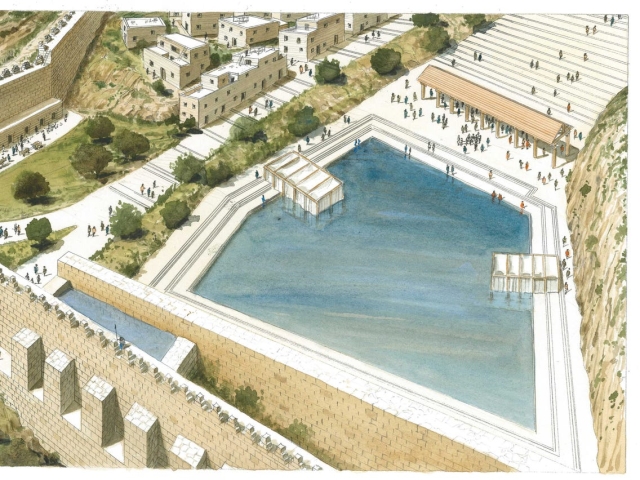In a momentous revelation that has captured the imaginations and hearts of those affiliated with both Jewish and Christian traditions, Jerusalem's hidden Pool of Siloam has been unveiled to the world. Long substantiated by Biblical narratives—including the recounting in the Gospel of John where Jesus healed a man born blind—this archaeological treasure had been shrouded in mystery for nearly two millennia, corresponding with the period when Jesus is historically thought to have lived. This recent discovery is monumental, not just as a testament to historical accuracy but also as a nexus for spiritual enlightenment and cross-cultural unity.
The commendable excavation initiative was a joint endeavor by several esteemed organizations: the Israel Antiquities Authority, the Israel National Parks Authority, and the City of David Foundation. United in their quest to uncover the past, these organizations have declared that they will open this sacred site to the general public in the near future. Their decision to do so acknowledges the pool's immeasurable value to both Christian and Jewish communities, who have long revered the sanctity of Jerusalem and its surrounding topographies.
AMAZING! Archaeologists in Jerusalem discovered 2000-year-old steps where Jesus walked and healed a blind man at the Pool of Siloam. pic.twitter.com/AbqVBDSV3G
— Hananya Naftali (@HananyaNaftali) September 10, 2023
Ze’ev Orenstein, the Director of International Affairs at the City of David Foundation, eloquently communicated the far-reaching implications of this discovery. Speaking to Fox News Digital, he said, “The ongoing excavations, particularly those focused on the Pool of Siloam and the Pilgrimage Road, fortify the deep-seated heritage and millennia-old ties that Jews and Christians maintain with Jerusalem.” Orenstein emphasized that these discoveries move beyond religious tenets to affirm the rich tapestry of Jerusalem’s history as empirical, observable fact, thereby bridging the realms of faith and factuality.
The Pool of Siloam's inception can be traced back to around 2,700 years ago, during the reign of King Hezekiah in the eighth century BC. Citing findings from the Biblical Archaeology Society, the pool was an integral component of a larger, sophisticated water system in the heart of ancient Jerusalem. Engineers of that era constructed a 1,750-foot subterranean tunnel beneath the City of David, designed to channel water from the vital Gihon Spring. Over the millennia, the pool underwent a myriad of modifications, expanding its dimensions to an impressive 1.25 acres, thereby bearing witness to Jerusalem's evolutionary trajectory.
The narrative of Jesus healing a blind man at the Pool of Siloam, as depicted in the Gospel of John, adds an additional layer of spiritual and historical depth. This singular event, recorded for posterity in sacred texts, further cements the pool's relevance to both Jewish and Christian theologies, intertwining it in a shared lineage of faith and tradition.
The Pool of Siloam and the Pilgrimage Road are featured prominently in “Route 60: The Biblical Highway.” Go to https://t.co/LY017DMMQb for tickets.
— David M Friedman (@DavidM_Friedman) September 7, 2023
Orenstein expanded upon the pool's broader relevance, describing the route from the Pool of Siloam along the Pilgrimage Road to the Temple Mount as “arguably the most significant half-mile on Earth.” His remark carries particular weight in a contemporary context marked by increasing skepticism toward religious and historical traditions. “The excavation of such undeniable historical artifacts and landmarks reiterates that our heritage in Jerusalem is not merely a matter of belief but a tangible, verifiable reality,” he noted.
Interestingly, the pool was initially discovered in 2004, almost serendipitously, during routine maintenance by the Hagihon water company. That inadvertent discovery led to a rigorous investigation by the Israel Antiquities Authority, culminating in the current groundbreaking findings.
Orenstein looks forward to a time when visitors will have the privilege of experiencing this consecrated space in an intimate manner. “People will soon have the unparalleled opportunity to lay their eyes on, touch, and even walk the same stones their forebears trod upon during their spiritual pilgrimages to Jerusalem thousands of years ago,” he said.
Archaeologists in Jerusalem said this week that an ancient site where Jesus healed a blind man have been uncovered, revealing a place not seen for more than 2,000 years. https://t.co/GD71bshgUM
— The Washington Times (@WashTimes) September 8, 2023
This significant archaeological landmark not only augments our understanding of Jerusalem’s intricate past but also serves as a tangible connective tissue to biblical stories that have informed and inspired countless generations globally. It stands as an enduring testament to a shared heritage and as an invitation to rediscover, appreciate, and preserve the roots of our collective spirituality.


